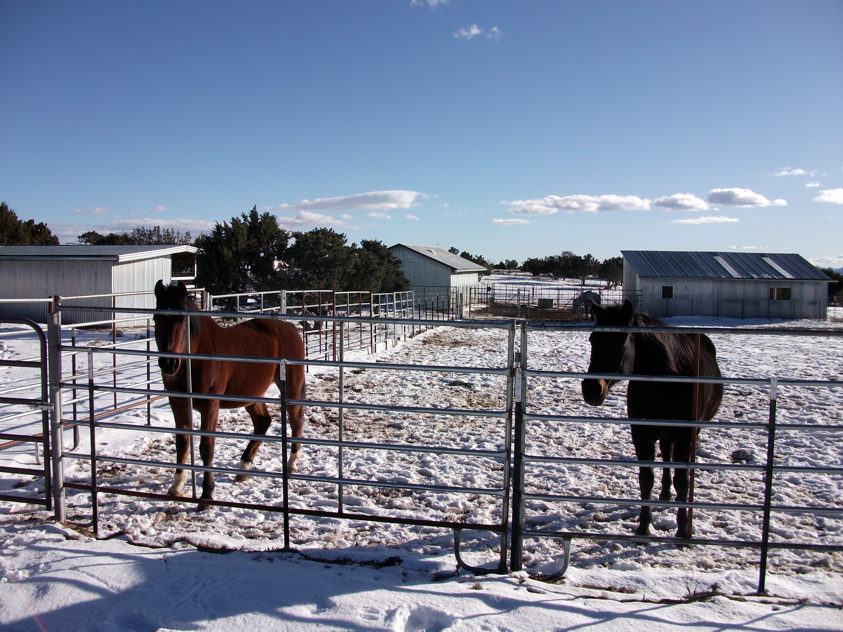
Winter at the Ranch. photos by George Johnson
Banking Jitters
In his book, Money, John Kenneth Galbraith described the reaction of George Ball, a diplomat and undersecretary of state in the Kennedy and Johnson administrations, when he left public office to make his fortune in the financial world. “Why,” he was overheard saying, “didn’t someone tell me about banking before?”
Just find a bunch of people with money they don’t immediately need and persuade them to let you hold it for safekeeping — in return for, say, half a percent a year in interest. Then you loan out the money at a higher rate. Rarely do you physically hand over cash to borrowers. Each time you make a loan, you “create” a new deposit. Now you have, on paper, even more money against which to lend. Since it’s unlikely that everyone will show up at the withdrawal window simultaneously, you can lend as much as 10 times the amount you have in these virtual deposits. If the house of cards collapses the federal government will step in and arrange a takeover.
When that happened last week to Charter Bank I wasn’t too worried. My money is at Los Alamos National, which was started years ago by a man I admire, George Cowan, a scientist and philanthropist who was also a founder of the Santa Fe Institute. With unbeatable service and community investment, the bank has always struck me as a class act. I was surprised when I learned in December (by following a link from the Reporter) that LANB had a “troubled asset ratio” of 44.6 — three times worse than the national average. And that was after the bank had received a $35.5 million infusion from the federal Troubled Asset Relief Program.
Still I was unprepared for the news, announced this week in a frustratingly opaque press release, that LANB has entered into an “agreement” with bank examiners (it sounds so friendly) “focused on reducing the Bank’s classified loans [“classified” is a euphemism for “troubled”] and reducing its loan concentration in commercial real estate.”
A story in Tuesday’s New Mexican was only slightly more enlightening, reporting (way down in the eighth paragraph) that LANB officials are “bringing in” a federal regulator — as though by invitation — “to work with the bank on its problem loans.” These are presumably in addition to those that have already gone bust and are listed in two pages of “discounted real estate” — another great euphemism — on the bank’s website. The repossessed property includes condos, houses, and lots at the stalled-out Oshara, Aldea, and Tessera subdivisions and, as mentioned here before, one of the famous Juanita Street condos. (Another has apparently been sold.) In addition, the Journal reported in December that the bank had filed a foreclosure complaint against Don Wiviott, the developer and unsuccessful Congressional candidate, for a property near the Railyard on Cerrillos Road.
“We’re experiencing everything every other bank is,” LANB’s president, William Enloe, told the New Mexican. But how many other banks have entered into “agreements” with regulators, and what does that mean? Judging from a document on the website of the Office of the Comptroller of the Currency, An Examiner’s Guide to Problem Bank Identification, Rehabilitation And Resolution, it sounds as though LANB has been slapped with something called a “formal action”:
A bilateral document [whose] provisions are set out in an article-by-article form to prescribe necessary corrective action. Violation of a formal agreement can provide the legal basis for more serious proceedings (e.g., cease and desist).
“Formal actions,” the document says, “are appropriate when a bank has significant problems, especially when there is a threat of harm to the institution.”
That sounds pretty serious. But without an inquiring reporter on the case, readers — and depositors — have no way to know.
George Johnson
The Santa Fe Review

Postscript, February 5. A story in this morning’s New Mexican serves as a reminder of another bad Los Alamos National Bank loan: to entrepreneur Charles Kokesh for the Santa Fe Horse Park. Mr. Kokesh, the father of Congressional candidate and Tea Partier Adam Kokesh, is also being pursued by the Securities and Exchange Commission and bankrupt Thornburg Mortgage.
Village People
It’s been just over a year since I drove out to the corner of Astral Valley Road and New Moon Overlook to see the Galisteo Basin Preserve, a land development that has been marketing itself as an ecologically inspired community of the future — a way to preserve a vast old cattle ranch by squeezing a densely packed development into the northeastern corner and leaving the rest as open space. What I found back then and described in an earlier installment struck me as another New Urbanist fantasy. When I read an editorial in Saturday morning’s New Mexican endorsing the project, I decided to go see if anything had changed.
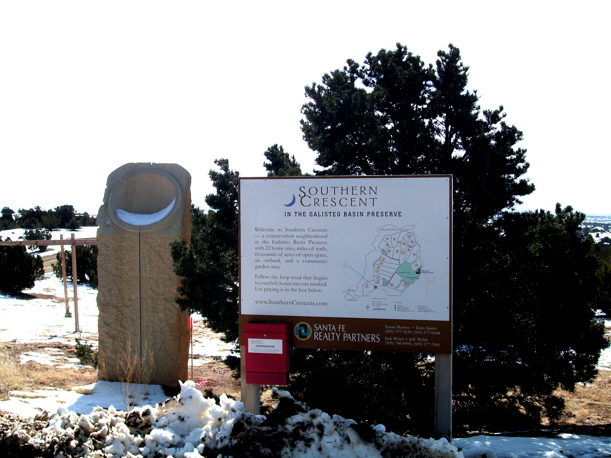
A section called Southern Crescent, where “22 home sites embrace a 100-tree orchard and community garden,” was just as I’d left it a year ago. The streets were platted and labeled with signs. Some lots were marked “sold.” But not a single residence had been built. The orchard was a field of sticks. Maybe these saplings will grow up someday to be shade trees, and maybe Southern Crescent will become a real place. But that’s the least of the developers’ grand plan.
What they say they envision is a “fine-grained, walkable community” of 965 closely spaced residences surrounding (how many times have we heard this?) a “vibrant village center” just like in a genuine, old fashioned town. There will be “a cafe, general store, post office, business incubator, outpatient medical facility, fire station, ATM, non-denominational place of worship, environmental center, and live-work space for artisans and businesses” — all the New Urbanist cliches. The high school will, of course, be “environmentally focused” and the community center will include “playfields, a library, a swimming pool, meeting spaces, and continuing-education classrooms.” They’ll probably teach acupuncture, iridology, and feng-shui.
The new town will be laid out according to “celestial alignments” — inspired, judging from an online presentation, by the mysterious Nazca Spirals of the Incas and the signs of the Zodiac. (Other inspirations include Anasazi cliff dwellings and the Alhambra.) Except for the New Age marketing, the details from the master plan look remarkably like those for the Northwest Quadrant. (Please see Sim City.) There is even an imaginary place called Happy Valley.
Maybe the motivation for all this is more quixotic than cynical. The front group for the project is a nonprofit corporation, Commonweal Conservancy, whose board overlaps with past and present members of the Trust for Public Land. They don’t hesitate to use that as a selling point. The same people also populate the board of Commonweal Communities, the for-profit subsidiary that is doing the actual development. It would be instructive to know how much money the visionaries stand to make.
Or how much they stand to lose. Before the County Commission rules on the next phase of this pipe dream, it might consider whether the old ranch really needs saving — there is no shortage of stillborn subdivisions in Santa Fe County — and whether the Village at Galisteo Basin Preserve has the slightest chance of ever attracting enough businesses to keep the 2,000 to 3,000 prospective residents from commuting 20 miles back and forth to Santa Fe. Similar plans haven’t worked in Aldea (please see Ballad of a Sad Cafe) or even in Rancho Viejo, where about all you can buy without hitting the road is a muffin and a cup of coffee.

Related Posts:
The New Urbanism Scam
Sim City
Unsustainability
Ballad of a Sad Cafe
Electromania
If there were such a thing as a license to be an investigative reporter Christopher Ketcham’s should be revoked. Mr. Ketcham is the author of an article in this month’s GQ Magazine, Warning: Your Cell Phone May Be Hazardous to Your Health, that has been spreading like swine flu through the Internet. Citing anecdotal evidence (an unidentified investment banker who is convinced, by God, that his brain tumor was caused by his cell phone) and cherry-picking material from ambiguous and much-disputed research papers, the author creates the illusion that there is a mass of scientific evidence linking cell phones to cancer, Alzheimer’s, and other maladies. Unmentioned in his piece is a study by the World Health Organization that came to the opposite conclusion:
In the area of biological effects and medical applications of [low level] radiation approximately 25,000 articles have been published over the past 30 years. Despite the feeling of some people that more research needs to be done, scientific knowledge in this area is now more extensive than for most chemicals. Based on a recent in-depth review of the scientific literature, the WHO concluded that current evidence does not confirm the existence of any health consequences from exposure to low level electromagnetic fields.
Studies by the European Commission’s Scientific Committee on Emerging and Newly Identified Health Risks and by the International Commission on Non-Ionizing Radiation Protection (both also disregarded by Mr. Ketcham) reached similar verdicts, as did a paper published last month in the Journal of the National Cancer Institute and summarized in Scientific American.
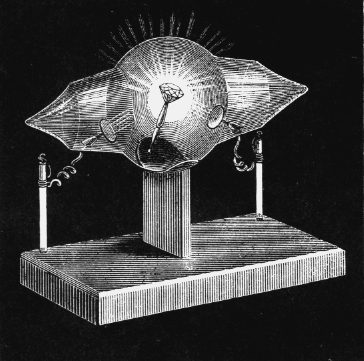
19th Century Cathode Ray Tube. (Invented by William Crookes, 1879)
These and other reports recognize that cell phones have not been in existence long enough to rule out the possibility of long-term effects and that more research on cell phone use by children may be called for — a rather tepid conclusion compared with what an innocent reader would take away from Mr. Ketcham’s skewed reporting. His article goes on to conflate cell phones with wifi — both transmit on about the same frequencies — even though there is a world of difference between holding a transmitter against your head and sitting across a room from one.
Most people turn to GQ for fashion advice not to deepen their understanding of complex issues. But when science is not on your side you take what you can get. On the front page of this morning’s New Mexican is a picture of William Bruno, a Los Alamos researcher and anti-wireless activist, holding up a copy of the Ketcham article at last night’s City Council meeting. Mr. Bruno, along with Arthur Firstenberg (the man who is suing his Santa Fe neighbor for using a cell phone) led the unsuccessful attempt to ban wifi from the public library and City Hall. Now they are opposing the approval of an updated telecommunication ordinance (the old one was overturned in federal court) and the approval of franchises by two companies that want to expand Santa Fe’s access to the infosphere — one with highspeed fiber optic cables and another with a distributed network of small wireless antennas. At one point, the New Mexican reports, Mr. Bruno became so upset that the police were called.
The Council tabled the measures and went on to pass a resolution calling for, among other things, the Federal Communications Commission to reassess the health effects of electromagnetic waves. Maybe the purpose was to get the hecklers out of the room, but the overall effect was to lend support to pseudoscience.
Also on the front page of today’s New Mexican is a story about a new venture by Google, which is enlisting municipalities to install and test ultra highspeed broadband — 100 to 1,000 times faster than what most of us have today. Santa Fe should be pushing to be first in line instead of wasting time trying to mollify a tiny number of people who blame their troubles on invisible rays.
George Johnson
The Santa Fe Review

Related posts:
Electromania, Part 2
Electromania, Part 3
What Science Really Knows About Wifi
Wi Fi Fo Fum
M.E.S.S. (Multiple Everything Sensitivity Syndrome)
Electromania, Part 2
Scientific truth is cumulative, and no single experiment can be taken as more than a clue. To be believed it must be replicated and stitched into the expanding web of knowledge. The journals are littered with isolated observations that turned out to be wrong.
In the comments section of the New Mexican story mentioned here yesterday, William Bruno, the anti-wireless activist, apologizes to the City Council for flying off the handle during the Tea Party-like chaos at Wednesday night’s meeting. Then he refers to four studies he takes as support for his views on the dangers of wireless technology:
I really could not contain my anger [he wrote] when the NewPath lawyer said they "wanted to be good neighbors." How can you be a good neighbor and install something that alters people's EEG (brainwave rhythm, see W. Bise 1978), causes headaches in literally a third of the population (Hutter 2006), causes sleep loss and nausea (Santini 2003)? . . .
(NewPath is the company that has applied for a franchise to install a system of small wireless antennas in town.) Further down, in response to another comment, Mr. Bruno writes:
You don't know the risks. All we have is data showing that cell phones AT LEAST double your risk of brain tumor. In experiments on mice, EVERY mouse had brain damage (Salford 2003) when exposed to cell phone levels of microwave radiation for just two hours . . .
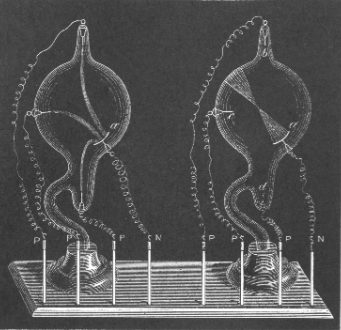
19th Century Cathode Ray Tube. (William Crookes, 1879)
Citation dropping, like name dropping, is a quick way to draw attention to yourself and your arguments. But what do the studies actually say? I couldn’t find an online version of the first one (Bise W., “Low power radio-frequency and microwave effects on human electroencephalograms and behavior,” Journal
Physiolo. Chem. Phys. [1978], 10[5]:387-398) probably because it is almost a third of a century old. Anyway, it is not too surprising that the electromagnetic field emitted by your cell phone might affect the shape of the electromagnetic field emitted by your brain. But is that dangerous? A research group at the University of Ottawa’s McLaughlin Centre for Population Health Risk Assessment methodically examined several studies, concluding that there were no persuasive signs of harm. The excellent FAQ on the group’s website should be read by our city councilors before they let themselves be blinded again by pseudoscience.
The other three papers Mr. Bruno cites are readily available on the Web. The Hutter study, he says, shows that wireless communication technology “causes headaches in literally a third of the population.” What it really found is far less alarming. First of all, the subjects were not cell phone users but people living near cell phone towers. After interviewing 365 of them, the researchers concluded that there was a greater-than-chance possibility that those exposed to higher levels of electromagnetism experienced more frequent headaches. Other research has found no such correlation.
In Santini 2003 French scientists mailed a questionnaire to volunteers and concluded that those who said they lived near cell towers were more likely to complain of sleeplessness, nausea, and other malaise. But again other studies contradict this. The University of Ottawa’s McLaughlin Centre provides some perspective: When you step back and look at the full body of research, there is no obvious link between headaches, amnesia, chronic fatigue, or other subjective symptoms and cell phone technology. Not for cell phone users or for those living near a transmitting station.
Finally there is Salford 2003 in which researchers exposed 32 rats to cell phone frequencies and then cut open their heads. They found what are known as “dark neurons,” which they interpreted as brain damage. The researchers conceded the difficulty of determining whether the effect was caused by cell phone radiation or by the trauma of what amounted to a brainectomy. In fact neurotoxicologists question whether dark neurons are really a sign of brain damage or just an experimental artifact.
Subtleties like these are beyond the ability of local governments to resolve. That is why the Telecommunications Act of 1996 doesn’t allow fears of health effects to be used as a reason for municipalities to block wireless technology that meets federal standards for the emission of electromagnetic waves. You can question the standards, but I’d rather have them decided in Washington than at Santa Fe City Hall.
George Johnson
The Santa Fe Review

Related post: Electromania, Part 1
Crime, Neuropsychology, and the Depressing Mayoral Race
Whenever you read a book or have a conversation, the experience causes physical changes in your brain. In a matter of seconds, new circuits are formed -- memories that can change forever the way you see the world. It's a little frightening to realize that every time you walk away from an encounter, your brain has been altered, sometimes permanently. And that people can impose these changes against your will. Someone can say something -- an insult, a humiliation -- and you carry it with you as long as you live. The memory is physically lodged inside you like a shard of glass healed inside a wound. Hurting someone with a rock is supposed to be different from hurting someone with an idea. But is it really? Since memories cause neurological changes -- sometimes painful ones -- the distinction between mental violence and physical violence becomes harder to understand.
I went back and reread those words (which I wrote, somewhat altered, in a book called In the Palaces of Memory) after reading Jason Auslander’s excellent article in the New Mexican about crime in Santa Fe and how it is being played by the two leading contenders in the mayoral race, incumbent David Coss and challenger Asenath Kepler. I like them both, as well as the underdog, Miguel Chavez, and am honored to count all three as readers. But I find it hard to stomach Mayor Coss’s implication that Santa Feans should take heart that violent crime is down, supposedly, even though residential burglaries are soaring.
It has been one year, seven months, and nine days since some goon or goons broke into our house while we were sleeping and wiped out my office, carrying away computers and disks with years of personal correspondence and other information. I had kept backups of almost everything, and insurance paid to replace the material goods. But I haven’t recovered the comfort I once felt in my home. I have trouble dismissing the psychological assault of the burglary as being somehow less invasive than a punch in the nose.
Even if you insist on limiting your definition of physical violence to that which draws blood, consider that since 2002 murder is up 55 percent, attempted murder is up 24 percent, and robbery is up 11 percent. Vehicular homicide is up 400 percent since 2006 when Mr. Coss took office. Before that it was zero. It was good to learn from the New Mexican that there have been small reductions in assault and battery and larger ones in rape and other sexual and domestic crimes. But can anyone reading the statistics really feel safer?
In his report Mr. Auslander shows that the Coss administration has not, as advertised, actually increased the size of the police force but only filled most of the vacancies. Great. We’re almost back to square one. Particularly discouraging is the solution the mayor offers to the burglary increase, to criminals forcing their way into our homes:
Coss blamed much of the residential burglary problem on juveniles and said he supports programs that help young people obtain job training and stay out of trouble.
As though the only reason these thugs are breaking and entering and permanently destroying our peace of mind is because they lack the skills to get hired at Walmart.
None of what I have just written means I would likely vote for Ms. Kepler, who has her own problems. Overall Mr. Coss has been a pretty good mayor who probably deserves another term. But what Santa Fe needs and never gets is a decisive, effective leader, one who inspires something stronger than faint praise.
George Johnson
The Santa Fe Review

Election 2010
Saturday morning on the Dale Ball Trails, as I kept to the edges to avoid the Cerro Gordo mud, I looked down and saw a rifle shell sitting in the snow. Back at the trailhead parking lot I’d noticed an empty six-pack left by Friday night partiers (16-ounce cans of Bud Light, the calorie counters’ choice) and I wondered if they had been out here shooting in the dark. Picking up the shell I saw that the inside was a little rusty. Maybe it had washed down from the hills, an artifact of an earlier time.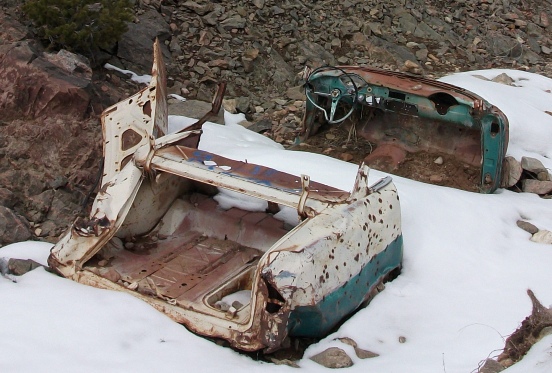
This is the stretch of trail that starts at the hairpin turn on Cerro Gordo Road and follows an arroyo north toward the Cerros Colorados subdivision with its lonely streets of million-dollar second homes. But the area used to be a semi-urban wilderness. A few hundred feet up the trail from the parking area is one of my favorite historical attractions: an old blue-and-white car — a Studebaker? — mired in the sand and riddled with bullet holes.
It seems like that should be a metaphor for something — Santa Fe’s city government or Tuesday’s mayoral election. But I can’t quite get my head around it. Campaign season here has been such a mush. The New Mexican reported this morning that the incumbent, Mayor David Coss, maintains a commanding lead. And judging from the campaign finance reports, he is set to raise a record amount of money — from developers and environmentalists, from realtors and historic preservationists, from Chamber of Commerce bigwigs and neighborhood activists — from people with conflicting interests and visions that cannot possibly be reconciled. Mr. Coss is the champion of the Living River and the Living Wage with big support from the Santa Fe Area Home Builders Association, the Thornburg and Zeckendorf dynasties, and the labor unions. So just whom and what would I be voting for?
The mayor’s strongest contender, Asenath Kepler, has received money in smaller bundles from an odd assortment that includes real estate attorney Kurt Sommer and Sagemaya Dandi, the squatter who lives in a tent in the woods above upper Canyon Road. She also has the support of former mayor Debbie Jaramillo. (Ms. Kepler was her city attorney and, as a favor, helped the mayor’s husband fight an income tax evasion charge.) But there is a decidedly right-wing cast to her support: New Mexican columnist Gregg Bemis, the Friends of Capitalism, madhatters from the local Tea Party, and, as the Coss campaign has eagerly pointed out, the Santa Fe Republican Women and the Republican Party itself. This is supposed to be a nonpartisan election, and in person Ms. Kepler doesn’t seem at all like an extremist. But a good shorthand for a person’s core beliefs about property rights, gun rights, and the role of government in a just society is their party affiliation.
So should I vote for the third candidate, Miguel Chavez, who has raised hardly any money (the few donors whose names stand out include former Councilor Karen Heldmeyer and her husband, Russ Mosteller, and William Herrera, the retired dentist who sold the land on which the new Super Walmart is being built)? Mr. Chavez is as sincere and decent a man as I can imagine finding his way into politics. But unless the polls are horribly mistaken he hasn’t a chance.
The City Council races are even harder to get worked up about. The incumbents in Districts 3 and 4 are running unopposed, either because their constituents universally love them or because they have given up on the process altogether. District 2, where I live, is rallying behind Councilor Rebecca Wurzburger, forgetting how her votes have encouraged a construction industry Gold Rush on the formerly historic east side and the legalization of vacation rentals. Her challenger, Stefanie Beninato, hasn’t been able to make much of an impression. The only real contest is in District 1 where Russell Simon, an intelligent young candidate with real, actual ideas is taking on Chris Calvert, who has a Master’s in Public Policy from Berkeley with undergraduate degrees in Conservation of Natural Resources and Aeronautical Engineering but works, for some reason, as a mail carrier. A third candidate, also a newcomer, is Doug Nava, a state tax examiner.
Once inside the voting booth I’ll probably pull the lever or check the box for Mr. Coss and for Ms. Wurzburger’s doomed opponent. Then we’ll all wake up Wednesday morning with everything pretty much the same.
George Johnson
The Santa Fe Review
